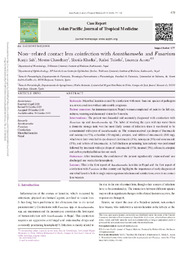Por favor, use este identificador para citar o enlazar este ítem:
https://hdl.handle.net/11000/34318Registro completo de metadatos
| Campo DC | Valor | Lengua/Idioma |
|---|---|---|
| dc.contributor.author | Sah, Ranjit | - |
| dc.contributor.author | Chaudhary, Meenu | - |
| dc.contributor.author | Khadka, Shusila | - |
| dc.contributor.author | Toledo, Rafael | - |
| dc.contributor.author | Acosta Soto, Lucrecia | - |
| dc.contributor.other | Departamentos de la UMH::Agroquímica y Medio Ambiente | es_ES |
| dc.date.accessioned | 2025-01-11T14:04:12Z | - |
| dc.date.available | 2025-01-11T14:04:12Z | - |
| dc.date.created | 2019-10-30 | - |
| dc.identifier.citation | Asian Pacific Journal of Tropical Medicine 2019; 12(10): 479-482 | es_ES |
| dc.identifier.issn | 1995-7645 | - |
| dc.identifier.issn | 2352-4146 | - |
| dc.identifier.uri | https://hdl.handle.net/11000/34318 | - |
| dc.description.abstract | Rationale: Microbial keratitis caused by coinfection with more than one species of pathogens is a severe condition with an unfavorable prognosis. Patient concerns: An immunocompetent Nepali woman complained of pain in the left eye, redness, watering and decreased vision for 5 months. Interventions: The patient was discarded and accurately diagnosed with coinfection with Fusarium sp. and Acanthamoeba sp. The habit of washing the eyes with tap water from a domestic storage tank was the most likely source of infection since it was found to be contaminated with cysts of Acanthamoeba sp. The woman received eye drops of fluconazole and natamycin (5%), cefazoline (50 mg/mL), atropine, and tablets of itraconazole (100 mg), which were later switched to eye drops of clotrimazole (1%), natamycin (5%) and voriconazole (1%), and tablets of itraconazole. A full thickness penetrating keratoplasty was performed followed by treatment with eye drops of voriconazole (1%), natamet (5%), ofloxacin, atropine and carboxymethylcellulose for one week. Outcomes: After treatment, the condition of the patient significantly improved and was discharged one week after keratoplasty. Lessons: This is the first report of Acanthamoeba keratitis in Nepal and the first report of coinfection with Fusarium in this country and highlights the importance of early diagnosis of microbial keratitis both in single microorganism infections and coinfections, even in no contact lens wearers | es_ES |
| dc.format | application/pdf | es_ES |
| dc.format.extent | 4 | es_ES |
| dc.language.iso | eng | es_ES |
| dc.publisher | Medknow Publications | es_ES |
| dc.rights | info:eu-repo/semantics/openAccess | es_ES |
| dc.rights | Attribution-NonCommercial-NoDerivatives 4.0 Internacional | * |
| dc.rights.uri | http://creativecommons.org/licenses/by-nc-nd/4.0/ | * |
| dc.subject | Acanthamoeba | es_ES |
| dc.subject | Fusarium | es_ES |
| dc.subject | Coinfection | es_ES |
| dc.subject | Microbial keratitis | es_ES |
| dc.subject | Nepal | es_ES |
| dc.title | Non-related contact lens coinfection with Acanthamoeba and Fusarium | es_ES |
| dc.type | info:eu-repo/semantics/article | es_ES |
| dc.relation.publisherversion | https://doi.org/10.4103/1995-7645.269909 | es_ES |

Ver/Abrir:
Non-related contact lens coinfection with Acanthamoeba and Fusarium.pdf
887,34 kB
Adobe PDF
Compartir:
 La licencia se describe como: Atribución-NonComercial-NoDerivada 4.0 Internacional.
La licencia se describe como: Atribución-NonComercial-NoDerivada 4.0 Internacional.
.png)